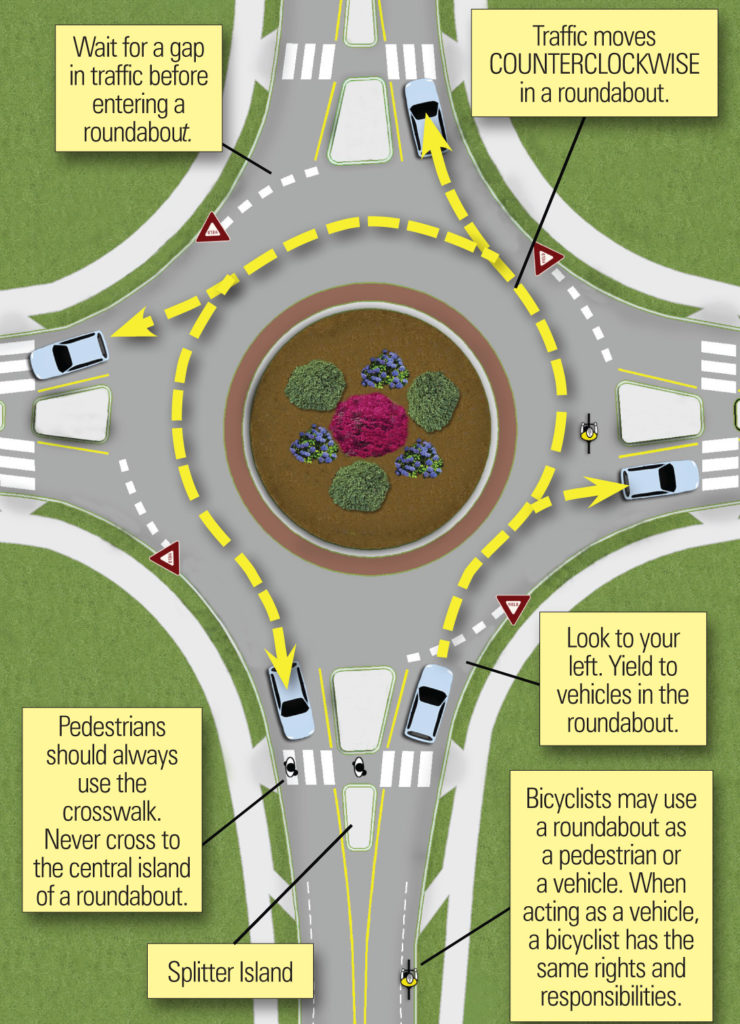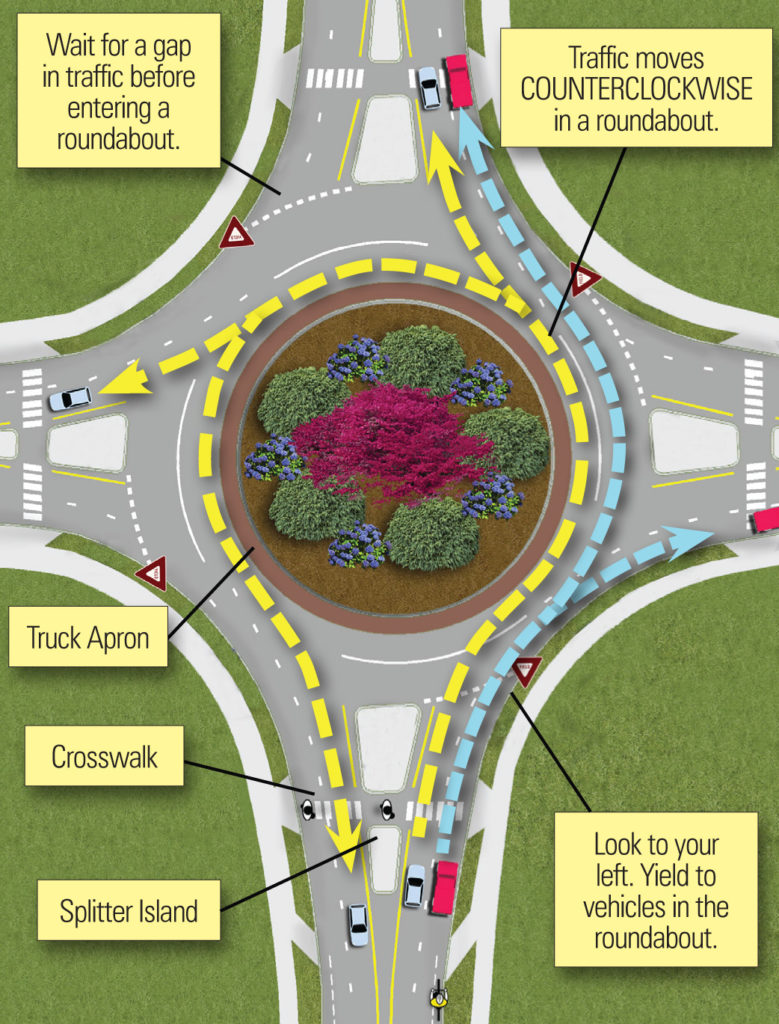Roundabout Information
Single-Lane Roundabouts

BE PREPARED FOR…
Emergency Vehicles
Do not enter the roundabout when emergency vehicles are approaching – pull to the side. If you are in the roundabout, exit at your intended exit then pull to the side. DO NOT STOP IN THE ROUNDABOUT.
Large Trucks
Roundabouts are designed to accommodate fire trucks and other large vehicles. A truck apron is provided around the central island for truck trailers to use, if necessary. The truck apron is several inches higher than the roadway pavement to discourage cars from using it.
SINGLE-LANE ROUNDABOUTS
Improved Safety
Roundabouts offer improved safety over other forms of at-grade intersections because roundabouts have fewer conflict points, slower speeds, and offer easier decision making. When comparing a single-lane roundabout to a signalized intersection, studies show that roundabouts experience a 90 percent reduction in fatal crashes, 75 percent fewer injury-causing crashes, a 30-40 percent reduction in pedestrian crashes, and a 10 percent reduction in bicycle crashes. These reductions are due to the elimination of most head-on, left turning across oncoming traffic, and right angle crashes.
Roundabouts improve pedestrian safety by allowing pedestrians to cross a single lane of slow, one-way traffic at a time.
Reduced Delay
Roundabouts typically carry about 30 percent more vehicles than similarly sized signalized intersections during peak flow conditions. During off-peak conditions, roundabouts cause almost no delay, but traffic signals can cause delay to side street and left-turning traffic from the major street. Increased capacity at roundabouts is due to the continuously flowing nature of yielding only until a gap is available, versus waiting at a signal.
Approaching and Entering:
When approaching the roundabout, SLOW DOWN and be prepared to yield to pedestrians in the crosswalk.
Approach the Yield Line, look to the left and check for approaching traffic within the roundabout. CIRCULATING TRAFFIC HAS THE RIGHT OF WAY.
Enter the roundabout when there is a safe gap in traffic. If necessary, stop at the Yield Line until there is a safe gap in traffic.
Circulation and Exiting the Roundabout:
Once you have entered the roundabout, proceed counterclockwise to your exit point. YOU now have the right of way.
As you approach your exit, use your RIGHT TURN SIGNAL.
Watch for pedestrians in the crosswalk and be prepared to yield.
Exit the roundabout.
Contact information
Pennsylvania Department of Transportation
Bureau of Project Delivery
PO Box 3161
Harrisburg, Pa 17105-3161
By phone: 717-787-5023
By email: [email protected]
On the Web: www.dot.state.pa.us
Multi-Lane Roundabouts

BE PREPARED FOR…
Emergency Vehicles
Do not enter the roundabout when emergency vehicles are approaching – pull to the side. If you are in the roundabout, exit at your intended exit then pull to the side. DO NOT STOP IN THE ROUNDABOUT.
Large Trucks
Motorists should be aware that large trucks using multi-lane roundabouts may require both lanes. A truck apron is provided around the central island for truck trailers to use, if necessary. Motorists should not attempt to pass a truck in a roundabout.
MULTI-LANE ROUNDABOUTS
Improved Safety
Roundabouts offer improved safety over other forms of at-grade intersections because roundabouts have fewer conflict points, slower speeds, and offer easier decision making. When comparing a multi-lane roundabout to a signalized intersection, studies show that roundabouts experience a 32 percent reduction in all crashes, and 68 percent fewer injury-causing crashes. These reductions are due to the elimination of most head-on, left turning across oncoming traffic, and right angle crashes.
Roundabouts improve pedestrian safety by allowing pedestrians to cross one-way traffic moving at much slower speeds.
Reduced Delay
Roundabouts typically carry about 30 percent more vehicles than similarly sized signalized intersections during peak flow conditions. During off-peak conditions, roundabouts cause almost no delay, but traffic signals can cause delay to side street and left-turning traffic from the major street. Increased capacity at roundabouts is due to the continuously flowing nature of yielding only until a gap is available, versus waiting at a signal.
NAVIGATION
Turning Right:
When approaching the roundabout, you must be in the RIGHT LANE unless otherwise marked on the road.
Slow down and be prepared to yield to pedestrians in the crosswalk.
Approach the Yield Line, look to the left and check for approaching traffic within the roundabout. CIRCULATING TRAFFIC HAS THE RIGHT OF WAY.
Enter the roundabout when there is a safe gap in traffic. Stay in the right lane. If necessary, stop at the Yield Line until there is a safe gap in traffic.
Use your right turn signal and exit the roundabout while staying in your lane.
Be prepared to yield to pedestrians in the crosswalk.
- Going Straight:
When approaching the roundabout, you can be in EITHER LANE unless otherwise marked on the road.
Slow down and be prepared to yield to pedestrians in the crosswalk.
Approach the Yield Line, look to the left and check for approaching traffic within the roundabout. CIRCULATING TRAFFIC HAS THE RIGHT OF WAY.
Enter the roundabout when there is a safe gap in traffic. Stay in your lane when going around. If necessary, stop at the Yield Line until there is a safe gap in traffic.
Use your right turn signal and exit the roundabout while staying in your lane.
Be prepared to yield to pedestrians in the crosswalk.
Turning Left or Making U-Turns:
When approaching the roundabout, you must be in the LEFT LANE unless otherwise marked on the road.
Slow down and be prepared to yield to pedestrians in the crosswalk.
Approach the Yield Line, look to the left and check for approaching traffic within the roundabout. CIRCULATING TRAFFIC HAS THE RIGHT OF WAY.
Enter the roundabout when there is a safe gap in traffic. Stay in the left lane. If necessary, stop at the Yield Line until there is a safe gap in traffic.
Yield to vehicles in outside lane. Use your right turn signal and exit the roundabout while staying in your lane.
Be prepared to yield to pedestrians in the crosswalk.
Contact information
Pennsylvania Department of Transportation
Bureau of Project Delivery
PO Box 3161
Harrisburg, Pa 17105-3161By phone: 717-787-5023
By email: [email protected]
On the Web: www.dot.state.pa.us
